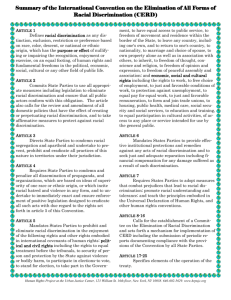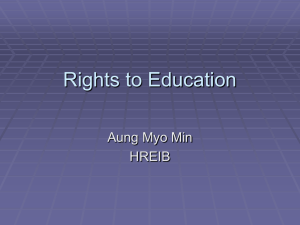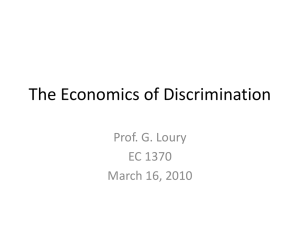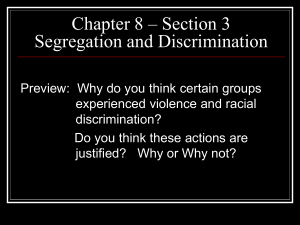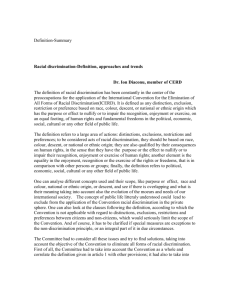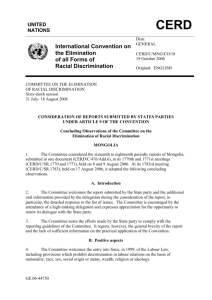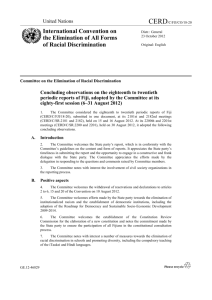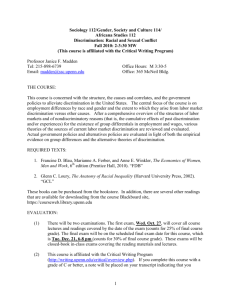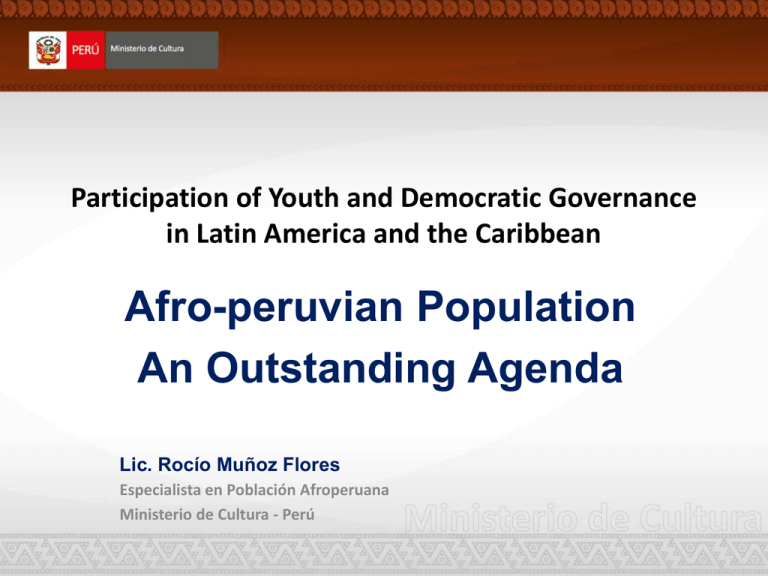
Participation of Youth and Democratic Governance
in Latin America and the Caribbean
Afro-peruvian Population
An Outstanding Agenda
Lic. Rocío Muñoz Flores
Especialista en Población Afroperuana
Ministerio de Cultura - Perú
Afro-peruvian population. ¿How many are
there?
•
•
•
•
According to the Civil Society Organizations, the afro-peruvian population ranges
between 8 - 10% of the total population , it means that we are talking about
almost 2 million people.
If we take into account the National Household Survey Information(NHSI) from
the fourth quarter of 2003, in which the variable of ethnic self-identification was
incorporated, the Afro-descendant population would represent 1% of the total
population of the Peru.
According to the ENCO in 2006, 150,516 afro-peruvian homes were identified;
they include 669,143 family members. Note that the survey highlights a significant
number of people auto-identified as afro-peruvians in Ayacucho (2,039 homes),
Arequipa (1,188 homes), Junín (1094 homes), andean regions.
According to ENAHO 2010 the afro-peruvian population will be the 3.1% of the
total.
Afro-peruvian population
• According to the Office of the Ombudsman’s report Nº 003–
2011–DP/ADHPD, “The Afrodescendants in Peru. An approach
to their reality and the exercise of their rights”, AfroPeruvians live in a situation of vulnerability, postponement
and invisibility that generates a negative impact on the full
exercise of their rights.
• According to a latest report of UNDP (2012) the Afro-Peruvian
population recorded lower levels of development than other
populations in the Peru.
Afro-peruvian population
Poverty
Health
• According ENAHO 2004 and ENCO
2006 the 35.7% of the Afro
Peruvians are in poverty which
exceeds the percentage of the
national
average
(34.8%).
National
Household
Survey
(NHS)
• The Office of the Ombudsman in
its latest report on Afro-Peruvian
population mentioned that 60%
of Afro-Peruvian families have
chronic diseases more than 11
points higher than the national
average percentage.
(report Nº 003–2011–DP/ADHPD, “Afrodescents in Peru. An
approach to their reality and the exercise of their rights)
Education
• Regarding university education only 2% of the Afro-Peruvian population,
manages to conclude their studies, according to reports the Peruvian State
in its periodic report to the Committee on the Elimination of Racial
Discrimination(CERD - 2008)
• In a recent study presented by UNDP on the socio-economic situation of
the Afro-Peruvian population (2012): the illiteracy rate has been reduced
by the Peru. However, according to the data of the ENAHO 2010, AfroPeruvians have 8.6% of illiterate people, similar percentage in statistical
terms than that recorded by the Indians. This illiteracy rate is almost
double the registered for mestizos that reachs to 4.7%.
• In the case of the Afro-Peruvian, the illiteracy rate exceeded men's by 6.7
percentage points, doubling it by far, data that shows the situation of
disadvantage they face in terms of education (UNDP, 2012).
CERD - COMMITTEE FOR THE ELIMINATION OF RACIAL DISCRIMINATION2009
Subjects of concern and recommendations
• Taking into account that the 1993 Political Constitution recognizes and
protects the ethnic and cultural plurality of the Peruvian nation, the
Committee remains concerned that a high percentage of persons
belonging to indigenous peoples and Afro-Peruvian communities continue
to suffer de facto racism and structural racial discrimination that exists in
the member State.
• The Committee recommends to the member State to undertake action to
combat racial discrimination through the elaboration of a global and
national policy against racism and racial discrimination. The Committee
further requests the member State to include in its next report indicators
on the enjoyment of the rights guaranteed in the draft of the
Constitution by the different indigenous peoples and Afro-Peruvian
communities, disaggregated by urban / rural population, age and sex.
CERD - Recommendations
•
•
•
The Committee recommends that the member State to continue improving the
methodology used in the census so that it reflects the complexity of Peruvian
society taking into account the principle of self-identification, in accordance with
its general recommendation No. 8 and paragraphs 10 to 12 of the guidelines
concerning the document specifically intended for the Committee to be
submitted by member States in accordance with paragraph 1 of article 9 of the
Convention(CERD/C/2007/1).
The Committee urges the member State to carry out a study on the AfroPeruvian population that allows to define their needs and to develop action
plans, programmes and effective public policies in all spheres of the public life of
the Afro-Peruvian communities.
The Committee encourages the member State to undertake actions in the short
and medium term for the effective implementation of measures that reduce
illiteracy among indigenous and Afro. Also the next report of the member State
shall contain precise data on the percentage of indigenous and Afro-Peruvians
who have access to primary, secondary and university education.
Perceptions of discrimination
• A research of the study for the defence of women's
rights (DEMUS 2004) indicates that indigenous
groups and Afridescents in the country are subject to
discriminatory practices to a greater extent than the
rest of the population. An study of GRADE states that
afroperuvians have affirmed to be subject of
discrimination especially by racial ethnic reasons
(Condevilla, Lima 31.4% de 237 respondents)
Bullying in school to young people aged between 12 and 18, by
household type
Bullying (nicknames and jokes) reported by young respondents
reveals significant differences. The racial content of these practices is
much greater in the case of young afro descendant homes, (GRADE:
Benavides Martin, 2011)
Discrimination and
Intersectionallity
• Racial discrimination interrelates with other
categories such as gender, class, 'race', sexuality, etc.
that exalt the conditions of discrimination and
subordination, contributing to strengthen the
mechanisms of exclusion and generating a context of
social inequality that is exacerbated by the
stereotypes and social representations around the
Afro-Peruvian population, in particular young
women.
The Impact
• Low educational and occupational mobility.
• Access to employment is much more complex in women and
young people.
• Unrecognized ability of entrepreneurship in young men and
women mainly
• Mostly negative social representations and impacting on
sexuality
• Stereotypes in relation to the academic and intellectual ability
• The media’s role in reproducing stereotypes
Viceministerio de Interculturalidad
ACTIONS TAKEN
Policy statements for Afro-peruvian population
• It will be an instrument that will define a set of guidelines for
the actions of the different sectors of the State in relation to
Afro-Peruvian population.
• It seeks to contribute to the design of strategies to promote
the development and the discrimination affecting AfroPeruvian population from an intercultural, intergenerational
and gender perspective.
• The document will result in the dialogue and contributions of
Afro-Peruvian organizations and the State.
• The development of this initiative has UNDP support.
Specialized survey for the Afroperuvian population
• With the recommendations of the Committee for elimination of Racial
Discrimination, the Action Plan of Durban and the Office of the
Ombudsman, we are coordinating the implementation of a specialized
survey to Afro-Peruvian population with INEI
• The survey will allow to obtain specific and disaggregated socio-economic
information on Afro-Peruvian population in order to achieve a baseline
that contributes to effectuate public policy for the development and
improvement of the quality of life of this important sector of the
population.
• A working group in which participates the State and civil society
institutions has been formed.
Institucionalization and Visibility
• Establishes the Direction of Afrodescendants Policies within the
Viceminister of Interculturality of the Minister of Culture, in order to have
better conditions for the political rectory and the mainstreaming of the
Afro-Peruvian agenda.
• Spaces of dialogue and coordination with the Afro-Peruvian civil society
organizations.
• Technical advice and assistance to the actions implemented in the various
sectors of the State at all levels.
• Create spaces to produce information through the dialogue and debate
facing the situation of the Afro-Peruvian population from an intercultural
and gender approach, with the participation of Afro-Peruvian
organizations, the academy and the State.
Lic. Rocío Muñoz Flores
Especialista en Población Afroperuana
Dirección General de Interculturalidad y Derechos de los Pueblos
Viceministerio de Interculturalidad
Ministerio de Cultura - Perú
rmunoz@mcultura.gob.pe - rocio.munozflores@gmail.com
Thanks



